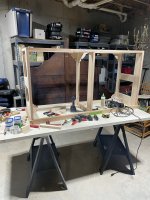Birdhunter
Member
- Joined
- Jun 16, 2012
- Messages
- 4,144
I’m building a large dresser and the “show” wood will be quarter sawn white oak. It has to be moved to its final home so I need to have the top, sides, and drawers removable to reduce weight.
I am using Baltic birch to build the frame to which the removable surfaces will be attached.
My trick is to cut 3” wide strips of 1/2” plywood and glue two together making a 1” thick board of whatever length I need. I glue the strips down against a cheap door I bought at Home Depot. The door is perfectly flat and square. So, the glued together strips are perfectly flat and square. I do separate the wood from the door using waxed paper.
Works great.
I am using Baltic birch to build the frame to which the removable surfaces will be attached.
My trick is to cut 3” wide strips of 1/2” plywood and glue two together making a 1” thick board of whatever length I need. I glue the strips down against a cheap door I bought at Home Depot. The door is perfectly flat and square. So, the glued together strips are perfectly flat and square. I do separate the wood from the door using waxed paper.
Works great.

